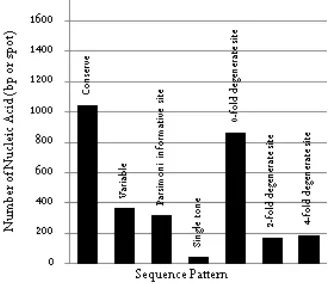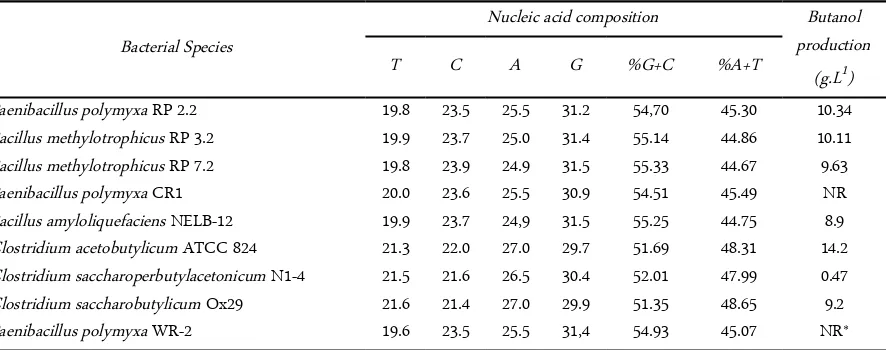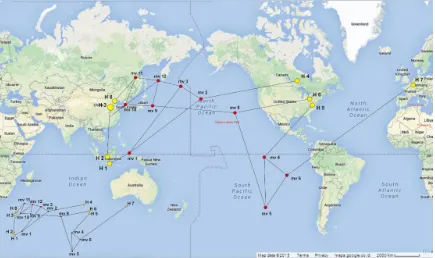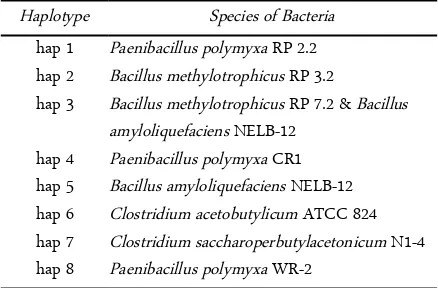Genomic and Haplotype Comparison of Butanol Producing Bacteria Based on 16S rDNA
Ekwan Nofa Wiratno1*
, Suharjono1
, Agustin Krisna Wardani2
1
Department of Biology, Faculty of Mathematics and Natural Sciences, Brawijaya University, Malang, Indonesia 2
Department of Agricultural Product Technology, Faculty of Agriculture Technology, Brawijaya University, Malang, Indonesia
ABSTRACT
High butanol demand for transportation fuel triggers butanol production development. Exploration of butanol-producing bacteria using genomic comparison and biogeography will help to develop butanol industry. The objectives of this research were butanol production, genome comparison and haplotype analysis of butanol-producing bacteria from Ranu Pani Lake sediment using 16S rDNA sequences. The highest butanol concentrations were showed by Paenibacillus polymyxa RP 2.2 isolate (10.34 g.L-1), followed by Bacillus methylotrophicus RP 3.2 and B. methylotrophicus RP 7.2 isolate (10.11 g.L-1 and 9.63 g.L-1) respectively. Paenibacillus polymyxa RP 2.2 showed similarity in nucleotide composition (ATGC) with B. methylotrophicus RP 3.2, B. methylotrophicus RP 7.2, P. polymyxa CR1, Bacillus amyloliquefaciens NELB-12, and Paenibacillus polymyxa WR-2. Clostridium acetobutylicum ATCC 824 showed similarity in nucleotide composition (ATGC) with Clostridium saccharoperbutylacetonicum N1-4, and Clostridium saccharobutylicum Ox29. The lowest G+C content was C. saccharobutylicum Ox29 (51.35%), and the highest was B. methylotrophicus RP 7.2 (55.33%). Conserved region of 16S rDNA (1044 bp) were consisted of 17 conserved sequences. The number of Parsimony Informative Site (PIS) was 319 spot and single tone was 48 spot. We found in this study that all of butanol-producing bacterial DNA sequences have clustered to 8 haplotypes. Based on the origin of sample, there were three haplotype groups. Bacteria from group A were could produce butanol 8.9-10.34 g.L-1, group B 9.2-14.2 g.L-1 and group C was could produce butanol 0.47 g.L-1. The haplotype analysis of bacteria based on 16S rDNA sequences in this study could predict capability of butanol production.
Keywords: 16S rDNA, bacteria, butanol, haplotype
Petroleum limitation gives effect to the develop-ment of bio-fuel to fulfill transportation demand. Bu-tanol and ethanol are alternative energy that was highly recommended for transportation. Butanol has higher energy density, lower heating value (LHV), higher hydrophobicity and lower evaporation than ethanol [1]. Butanol can be produced by Clostridium [2], Bacillus, and Paenibacillus [3; 4].
Clostridium acetobutylicum, Clostridium beijer-inckii, and Clostridium saccharoperbutylacetonicum, are Clostridia species that could produce butanol [5]. The number of Bacillus and Paenibacillus that could produce butanol, there are Bacillus sp. 15, Bacillus
amyloliquefaciens NELB-12 [4; 6], and Paenibacillus polymyxa CR1 [3].
Microbial biogeography is essential to predict me-tabolism and other activity that will give an advantage to human [7]. However, there have not been any anal-ysis on relationship between butanol production and microbial biogeography. The objective of this study is to compare butanol production capability, profile nu-cleotide composition and analyse haplotype based on 16S rDNA sequences.
Collection of the samples
Samples were collected from 5 locations of Ranu Pani edge, Indonesia. Samples stored in ice boxes. Bac-terial reference sequences accessed from Genebank NCBI (http://www.ncbi.nlm.nih.gov/). Information on butanol production capability was obtained from some references (Table 1).
MATERIALS AND METHODS INTRODUCTION
*Corresponding author: Ekwan Nofa Wiratno
Department of Biology, Faculty of Mathematics and Natural Sciences, Brawijaya University, Malang, Indonesia
Tabel 1. PCR composition material
Table 2. Reaction condition for PCR
No. Reaction Temperature (oC) Time (min)
1 Initial denature 94 4
2 35 cycles:
Denature 94 1
Annealing 55 1
Extension 72 1
3 Final extension 72 5
Isolation of bacteria
Twenty five grams of sediment from Ranu Pani Lake was suspended in 225 ml sterile aquadest. Sus-pension was diluted serially until 10-6 and added 9 ml Tryptone Yeast Extract Acetate (TYA) agar medium (6 g bacto tryptone (Bacto); 2 g yeast extract (Bacto); 3 ml acetic acid; 0.5 g KH2PO4; 0.3 g MgSO4.7H2O; 0.01 g
FeSO4.7H2O; 20 g glucose and 20 g agar (Bacto) per
liter, pH 6,5 standardized using 1 N NaOH and steril-ized at 115°C, 15 minutes) [8] and incubated at 27°C for 48 hours.
Butanol production
Two and half mililiter of bacterial culture in Thioglicolate medium (was incubated at 30°C, 48 hours) was transferred to 22.5 mL modified TYA medium pH 6.5 (without glucose, added 1% filter pa-per Whatmann no 1) and incubated at 30°C, 7 days. Butanol was measured at the end of fermentation using Gas Chromatography (GC).
16S rDNA isolation and amplification
DNA was isolated from the highest butanol pro-ducing isolates using a modified method of Ausubel et al. [9]. Sequences of 16S rDNA were amplified using a couple of primer (27F: 5'-AGAGTTTGATCMTG-GCTC-3'; 1492R: 5'-GGTTACCTTGTTACGACTT-3') [10]. Material composition and reaction condition of PCR are shown in Table 1 and Table 2 [11].
16S rDNA purification and sequencing
Purification and sequencing of 16S rDNA sequence performed in First Base, Malaysia. Sequences were sub-mitted to NCBI (KT036393, KT036394, and KT036395).
16S rDNA profiling
16S rDNA was profiled (nucleic acid composition, pattern and conserve sequences) using Bioedit and MEGA 6.06 for Windows.
Haplotype
Sequences of 16S rDNA bacteria were analysis hap-lotype using DNAsp 5 and Haphap-lotype Network 4.6.1.3 for Windows.
Butanol production
There are 13 isolates of bacteria cultured from Ranu Pani Lake sediment. The highest butanol concentrations were resulted by P. polymyxa RP 2.2 isolate (10.34 g.L-1, in 3 days fermentation) and then Bacillus methylotrophicus RP 3.2 and B. methylotrophicus RP 7.2 isolate (10.11 g.L-1, in 5 days and 9.63 g.L-1, in 3 days fermentation) using filter paper substrate. On the other hand, Table 4 shows that B. amyloliquefaciens NELB-12 could produce 8.9 g.L-1 butanol using 30 g.L-1 starches [4]. Using CMC C. Saccharoperbutylacetonicum N1-4 could produce 0.47 g.L-1 butanol [12] whereas C. acetobutylicum ATCC 824 and Clostridium saccharobutylicum Ox29 could produce 14.2 g.L-1 (using 80 g.L-1 glucose) and 9.2 g.L
-1
(using 60 g.L-1 glucose) butanol [13, 14]. There is no information on butanol production capability for Paenibacillus. Some references only refer those potential [15, 16].
Figure 1. Butanol-producing bacterial 16S rDNA pattern RESULTS AND DISCUSSION
No. Solution Volume (µL) Concentration
1 ddH2O 6
2 PCR mix (i-TaqTM) 15
3 Primer Forward 3 30 pmol
4 Primer Reverse 3 30 pmol
5 DNA template 3 <1µg
16S rDNA profiling
16S rDNA sequence composition were varied be-tween all bacteria (Table 4). P. polymyxa RP 2.2 showed similarity in nucleotide composition (ATGC) with B. methylotrophicus RP 3.2, B. methylotrophicus RP 7.2, P. polymyxa CR1, B. amyloliquefaciens NELB-12, and P. polymyxa WR-2. C. acetobutylicum ATCC 824 showed similarity in nucleotide composition (ATGC) with C. saccharoperbutylacetonicum N1-4, and C. saccharobutylicum Ox29. G+C content is about 51.35-55.35%. The lowest G+C content was C. saccha-robutylicum Ox29 (51.35%), and the highest was B. methylotrophicus RP 7.2 (55.33%).
The environment plays an active role in shaping GC content, such as surface water vs. soil, and bacteria living in aquatic conditions have an average low GC
content (~34%), whereas soil-dwellers have an elevated high GC content (~61%) [17]. P. polymyxa RP 2.2, B. methylotrophicus RP 3.2, B. methylotrophicus RP 7.2 had 54-55% G+C content and isolated from sediment sample.
Sequences of 16S rDNA were formed some patttterns, which are conserved region, variable region, Par -simony informative site (PIS), single tone, 0-fold de-generate site, 2-fold dede-generate site and 4-fold degener-ate site (Figure 1). Conserved region of 16S rDNA (1044 bp) were consisted of 17 conserved sequences. The number of Parsimony Informative Site (PIS) was 319 spot and single tone was 48 spot. The number of 0-fold degenerate site, 2-fold degenerate site, and 4-fold degenerate site as much as 865, 169 and 188. There are 17 conserved sequences (Table 5).
Table 3. Butanol-Producing bacterial identity
Table 4. Nucleic acid composition and butanol production of butanol-producing bacteria
*NR: Number of reference
No Bacterial Species Source Accession Number References
1 Paenibacillus polymyxa RP 2.2 East Java, Indonesia KT036393 This study 2 Bacillus methylotrophicus RP 3.2 East Java, Indonesia KT036394 This study 3 Bacillus methylotrophicus RP 7.2 East Java, Indonesia KT036395 This study 4 Paenibacillus polymyxa CR1 Ontario, Canada KF620436 Eastman et al., 2014 5 Bacillus amyloliquefaciens NELB-12 Beijing, China KF418240 El-Hadi et al., 2014 6 Clostridium acetobutylicum ATCC 824 Pennsylvania U16166 Bayer et al., 2008
Al-Shorgani et al., 2011 7 Clostridium saccharoperbutylacetonicum N1-4 Pennsylvania U16122 Bayer et al., 2008
Al-Shorgani et al., 2011 8 Clostridium saccharobutylicum Ox29 Freising, Germany AM998793 Bayer et al., 2008 9 Paenibacillus polymyxa WR-2 Jiangsu, China KF224925 Eastman et al., 2014
Bacterial Species
Nucleic acid composition Butanol production
(g.L1)
T C A G %G+C %A+T
Paenibacillus polymyxa RP 2.2 19.8 23.5 25.5 31.2 54,70 45.30 10.34 Bacillus methylotrophicus RP 3.2 19.9 23.7 25.0 31.4 55.14 44.86 10.11 Bacillus methylotrophicus RP 7.2 19.8 23.9 24.9 31.5 55.33 44.67 9.63
Paenibacillus polymyxa CR1 20.0 23.6 25.5 30.9 54.51 45.49 NR
Bacillus amyloliquefaciens NELB-12 19.9 23.7 24,9 31.5 55.25 44.75 8.9 Clostridium acetobutylicum ATCC 824 21.3 22.0 27.0 29.7 51.69 48.31 14.2 Clostridium saccharoperbutylacetonicum N1-4 21.5 21.6 26.5 30.4 52.01 47.99 0.47 Clostridium saccharobutylicum Ox29 21.6 21.4 27.0 29.9 51.35 48.65 9.2
Table 5. Conserve region of butanol-producing bacterial sequences
Figure 2. Haplotype network of butanol-producing bacteria (overlay with map)
No. No. of base Nucleic Base (5’-3’)
Start End
1 45 69 AGCGGCGGACGGGTGAGTAACACGT
2 235 261 CGATGCGTAGCCGACCTGAGAGGGTGA
3 289 313 CCAGACTCCTACGGGAGGCAGCAGT
4 348 369 AGCAACGCCGCGTGAGTGATGA
5 467 503 --CTAACTACGTGCCAGCAGCCGCGGTAATACGTAGG
6 505 521 GGCAAGCGTTGTCCGGA
7 647 668 GTGTAGCGGTGAAATGCGTAGA
8 682 697 ACCAGTGGCGAAGGCG
9 729 743 GAAAGCGTGGGGAGC
10 745 771 AACAGGAT--TAGATACCCTGGTAGTC 11 773 789 CACGCCGTAAACGATGA
12 859 874 AGTACGGTCGCAAGA
13 937 966 --AATTCGAAGCAACGCGAAGAACCTTACC
14 1028 1100 GACAGGTGGTGCATGGTTGTCGTCAGCTCGTGTCGTGAGATGTTGGGTTAAGT CCCGCAACGAGCGCAACC
15 1165 1207 GGAGGAAGGTGGGGATGA-CGTCAAATCATCATGCCCCTTATG 16 1366 1386 CGCGGTGAATACGTTCCCGGG
Table 6. Haplotype of butanol-producing bacterial sequences
Haplotype of 16S rDNA
All sequences of butanol-producing bacteria were grouped to 8 haplotypes (Figure 2). Haplotype 3 is consisting of B. amyloliquefaciens NELB-12 and B. methylotrophicus RP 7.2. Haplotype 1 is P. polymyxa RP 2.2, haplotype 2 is B. methylotrophicus RP 3.2. An-other species were grouped to An-other haplotypes (Table 6). Based on the origin of sample, there were three haplotype groups. Group A was isolated from Asia (hap 1, 2, 3 and 8), group B was isolated from America (hap 4, 5 and 6) and group C was isolated from Europe (Hap 7) (Figure 2). Bacteria from group A could pro-duce butanol 8.9-10.34 g.L-1, group B 9.2-14.2 g.L-1 and
group C could produce butanol 0.47 g.L-1.
Distribution and difference of butanol-producing bacteria was caused by many factors. Bacteria are very influenced by environmental condition, such as tem-perature, altitude, humidity, gasses, salinity, biotic and other factors [18]. Distance of every ecosystems or mi-cro-ecosystems gives significant of phenotype and genotype characteristics of bacteria [19].
Therefore, even under similar environmental condi-tions, microbial communities from different placeses might function differently. A better understanding of microbial biogeography is essential to predict such effffects. It is also crucial in the search for novel pharma -ceutical and other compounds of industrial importance [7].
High butanol production were showed by P. polymyxa RP 2.2, B. methylotrophicus RP 3.2 and B. methylotrophicus RP 7.2 isolate. All isolates showed different nucleotid composition. All of butanol-produc-ing bacterial DNA sequences have clustered to 8 haplo-types. The haplotype analysis of bacteria based on 16S rDNA sequences in this study could predict capability
of butanol production.
This research was supported and facilitated by PHK programs for graduate student of Biology Departe-ment, University of Brawijaya, Malang, Indonesia.
1. Pfromm PH, Boadu VA, Nelson R, Vadlani P, Madl R (2009) Bio-butanol vs. bioethanol: a technical and eco-nomic assessment for corn and switchgrass fermented by yeast or Clostridium acetobutylicum. Biomass Bioenergy 34: 515-524.
2. DÜrre P, (2008) Fermentative butanol production bulk chemical and biofuel. Annals of the New York Academy of Sciences 1125: 353-362.
3. Eastman WA, Weselowski B, Nathoo N, Yuan ZC (2014) Complete genome sequence of Paenibacillus polymyxa CR1, a plant growth-promoting bacterium isolated from the corn rhizosphere exhibiting potential for biocontrol, biomass degradation, and biofuel production. Genome Announcements 2(1): e01218-13.
4. El-Hadi D, Zheng Z, Dong C (2014) Aerobic production of butanol with Bacillus amyloliquefaciens NELB-12. Ap-plied Mechanics and Materials 473: 1005-110.
5. Bayer EA, Lamed R, White BA, Flint HJ (2008) From cel-lulosomes to cellulosomics. The Chemical Record 8: 364-377.
6. Ng CYC, Takahashi K, Liu Z (2015) Isolation, characteri-zation, and optimization of an aerobic butanol producing bacterium from Singapore. Biotechnology and Applied Biochemistry 1343: 1-20.
7. Bull AT (ed). (2003) Microbial Diversity and Bioprospect-ing. ASM Press. Washington DC.
8. Ambarsari H, Sonomoto K (2013) Production of Acetone, Butanol, and as Bioenergy Source materials by Clostrid-ium saccharoperbutylacetonicum N1-4 (ATCC 13564) us-ing Different Substrates. Microbiology Indonesia 7 (3): 113-123.
9. Ausubel FM, Brent RE, Kingston DD, Moore JG, Seid-man JA, Smith, Struht (1995) Short Protocol in Molecular Biology. Willey. New York.
10. Turner S, Pryer KM, Miao VPW, Palmer JD (1999) Inves-tigating deep phylogenetic relationships among cyanobac-teria and plastids by small subunit rRNA sequence analy-sis. Journal of Eukaryotic Microbiology 46: 327–338. 11. Liu FH, Wang SB, Zhang JS, Zhang J, Yan X, Zhou HK,
Zhao GP, Zhou ZH (2009) The structure of the bacterial and archaeal community in a biogas digester as revealed by denaturing gradient gel electrophoresis and 16S rDNA sequencing analysis. Journal of Applied Microbiology 106: ACKNOWLEDGMENT
REFERENCES
CONCLUSIONS
Haplotype Species of Bacteria
hap 1 Paenibacillus polymyxa RP 2.2 hap 2 Bacillus methylotrophicus RP 3.2
hap 3 Bacillus methylotrophicus RP 7.2 & Bacillus amyloliquefaciens NELB-12
952–966.
12. Al-Shorgani NKN, Kalil MS, Yusoff WMW (2011) The eff-ffect of different carbon sources on biobutanol production
using Clostridium saccharoperbutylacetonicum N1-4. Biotechnology 10 (3): 280-285.
13. Berezinaa OV, Brandtb A, Yarotskya S, Schwarzb WH, Zverlov VV (2009) Isolation of a new butanol-producing Clostridium strain: High level of hemicellulosic activity and structure of solventogenesis genes of a new Clostrid-ium saccharobutylicum isolate. Systematic and Applied Microbiology 32: 449–459.
14. Lee J, Jang YS, Choi SJ, Im JA, Song H, Cho JH, Seung YD, Papoutsakis ET, Bennett GN, Lee SY (2012) Meta-bolic engineering of Clostridium acetobutylicum ATCC 824 for isopropanol-butanol-ethanol fermentation. Ap-plied and Environmental Microbiology 78: 1416–1423. 15. Eastman WA, Heinrichs DE, Yuan ZC (2014)
Compara-tive and genetic analysis of the four sequenced Paenibacil-lus polymyxa genomes reveals a diverse metabolism and conservation of genes relevant to plant-growth promotion
and competitiveness. BMC Genomics 15 (851): 1471-2164. 16. Raza W, Yuan J, Ling N, Huang Q, Shen Q (2015) Pro-duction of volatile organic compounds by an antagonistic strain Paenibacillus polymyxa WR-2 in the presence of root exudates and organic fertilizer and their antifungal activity against Fusarium oxysporum f. sp. niveum. Bio-logical Control 80: 89–95.
17. Foerstner KU, von Mering C, Hooper SD, Bork P (2005) Environments shape the nucleotide composition of genomes. EMBO Rep 6: 1208-1213.
18. Bassler B, Miller MB (2006) Quorum sensing. in M. Dworkin, S. Falkow, E. Rosenberg, K. H. Schleifer & E. Stackebrandt. The Prokaryotes: ecophysiology and bio-chemistry, third edition. Springer science. Singapore. 19. Martiny JBH, Bohannan BJM, Brown JH, Colwell RK,



